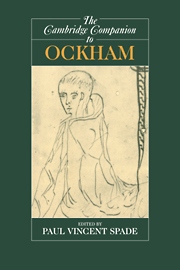Book contents
- Frontmatter
- Introduction
- 1 The Academic and Intellectual Worlds of Ockham
- 2 Some Aspects of Ockham's Logic
- 3 Semantics and Mental Language
- 4 Is There Synonymy in Ockham's Mental Language?
- 5 Ockhams' Nominalist Metaphysics
- 6 Ockham's Semantics and Ontology of the Categories
- 7 Ockham's Philosophy of Nature
- 8 The Mechanisms of Cognition
- 9 Ockham's Misunderstood Theory of Intuitive and Abstractive Cognition
- 10 Ockham's Ethical Theory
- 11 Ockham on Will, Nature, and Morality
- 12 Natural Law and Moral Omnipotence
- 13 The Political Writings
- 14 Ockham on Faith and Reason
- 15 Ockham's Repudiation of Pelagianism
- Bibliography
- Citations
- Index
3 - Semantics and Mental Language
Published online by Cambridge University Press: 28 May 2006
- Frontmatter
- Introduction
- 1 The Academic and Intellectual Worlds of Ockham
- 2 Some Aspects of Ockham's Logic
- 3 Semantics and Mental Language
- 4 Is There Synonymy in Ockham's Mental Language?
- 5 Ockhams' Nominalist Metaphysics
- 6 Ockham's Semantics and Ontology of the Categories
- 7 Ockham's Philosophy of Nature
- 8 The Mechanisms of Cognition
- 9 Ockham's Misunderstood Theory of Intuitive and Abstractive Cognition
- 10 Ockham's Ethical Theory
- 11 Ockham on Will, Nature, and Morality
- 12 Natural Law and Moral Omnipotence
- 13 The Political Writings
- 14 Ockham on Faith and Reason
- 15 Ockham's Repudiation of Pelagianism
- Bibliography
- Citations
- Index
Summary
At the outset of SL, Ockham endorses Boethius's old distinction between three sorts of discourse: written, spoken, and mental. The first two, he explains, are physically perceptible, whether by the eye or by the ear, and are made up of conventional signs. The units of mental language, by contrast, are concepts. They are internal to thinking minds, and their signification is natural rather than conventional. Being mental, they are not directly perceptible - at least not in this world - to anybody but the person who internally produces them in the course of his or her private thinking. But being originally acquired as the result of a natural process, they are nevertheless strongly similar - and identically organized - from one human being to another. Although it is not a public medium of communication, mental language is potentially common to all. Mental language is prior to, and underlies, every reasonable speech utterance and provides it with meaning. Ockham's semantical theory, as presented in SL and elsewhere, is primarily an explication of the various ways in which the natural conceptual signs that constitute the language of thought are linked with their external referents; and secondarily, of the ways in which conventional discourse is derived from this mental language.
- Type
- Chapter
- Information
- The Cambridge Companion to Ockham , pp. 53 - 75Publisher: Cambridge University PressPrint publication year: 1999
- 21
- Cited by



